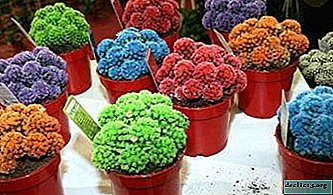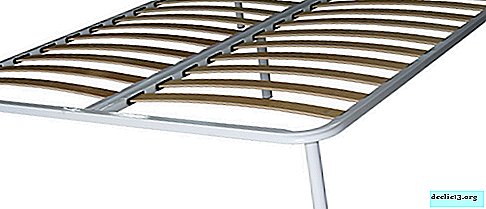A modest but cute indoor geranium: popular varieties and rules for home care

Indoor geranium remains the most popular houseplant for many years. This flower has earned such success for its spectacular appearance and unpretentiousness to growing conditions.
Pelargonium is famous for its mass of medicinal properties and is actively used in traditional medicine.
All home geraniums are divided into 2 groups: fragrant and flowering.
Next, we will consider the popular varieties and rules for home care.
Botanical description and history of the plant
 Indoor geranium is a perennial shrub or herbaceous plant from the geranium family. There are more than 400 varieties of this flower, growing around the world, including in tropical areas. The flower received its name from the Greek word "crane", due to the shape of the fruit - in geraniums they resemble a crane beak.
Indoor geranium is a perennial shrub or herbaceous plant from the geranium family. There are more than 400 varieties of this flower, growing around the world, including in tropical areas. The flower received its name from the Greek word "crane", due to the shape of the fruit - in geraniums they resemble a crane beak.
In the 17th century, pelargonium was introduced to Europe from Africa. A beautiful plant with bright flowers and a peculiar smell quickly gained popularity in the circles of aristocrats, over time, the plant began to spread among other classes. Pelargonium appeared in Russia in the 18th century and was also loved by gardeners.
What does it look like and when does it bloom?
Most varieties of indoor pelargonium are branched half-shrubsj. It has a developed root system adapted to dry conditions.
The shape of the leaves is round, usually green with a pronounced reddish circle. Some other varieties may have different color options, for example, a white border is present on the sheet or the entire surface of the green mass is painted in purple.
Inflorescences of geraniums in the form of an umbrella, flowers can be simple, dissected or double. The inflorescence in diameter reaches 15 cm, in some varieties - up to 20 cm. The flowers are of the correct form, five-leafed, the color can be very diverse. Most often there are varieties with a color of flowers in red tones, from burgundy to light pink. Various shades of blue and violet colors are also possible.
Geranium fruits are a box that looks like a beak of a crane or a stork, inside which the seeds of the plant are stored.
Popular varieties: names and brief information
Among all varieties of room geraniums, the following are most popular:
- Miniature varieties. These include plants whose height reaches no more than 25 cm. The most popular of these are Francis Parrett, Jane Eyre, Pensby.
- Healing geranium - can not boast the same spectacular appearance as decorative. When growing, the main emphasis is on building green mass.
- Pelargonium is blue. Varieties with such an original color include Johnsons Blue, Himalayan (read about the Himalayan Plenum here).
You will learn more about indoor varieties and garden geraniums in this article.
Photo
Below you can see a photo of room geranium flowers, including undersized, blue and medicinal.



How to plant?
Pelargonium is grown in two ways: from seeds and from cuttings.
Seeding Rules
Planting room geranium seeds is a time-consuming and lengthy process. Usually experienced gardeners resort to this method of planting solely to grow a new plant variety. Due to the fact that newcomers often fail to grow a flower from seeds, it is recommended to use seeds of inexpensive varieties for starters.
- For seed germination, a loose texture soil is required; to achieve this, it is necessary to add humus and sand to the soil.
- Planting of seeds is carried out in early March or earlier, provided that the sprouts provide a large amount of light. In winter, the sprouts are highlighted with special phytolamps.
- Before planting, the soil is watered with a weak solution of potassium permanganate - this is necessary for disinfecting the soil in order to avoid root diseases in the future sprout. After this, the seeds are sown in the soil, slightly deepening, but not sprinkling soil on top.
- Next, you need to cover the pot with a film and send the future seedlings to a warm place to create a greenhouse effect. This will have a beneficial effect on seed germination.
Growing pelargonium from the cuttings
 Planting cuttings is a simple procedurethat even a beginner grower can handle.
Planting cuttings is a simple procedurethat even a beginner grower can handle.
- Before planting, cuttings must be prepared for planting in the ground. For this, freshly cut cuttings are placed in water to form roots. In the room where the stem grows, it is important to maintain a high temperature.
- When the roots appear on the stalk, it is removed from the water and given a little time so that the moisture from the surface of the sprout evaporates.
- The cuttings are planted in soil treated with manganese. As soon as the first signs of growth are noticeable, it is necessary to pinch off the top of the sprout.
Choosing a place in the room
The main guarantee of good growth and flowering of a houseplant is sufficient illumination. Geranium needs a lot of sunlight, so it is recommended to place a pot with this flower near the windows on the south side.
Important! With excessively bright sunlight, for example, on a summer afternoon, pelargonium still needs to be shaded, otherwise a burn of the plant leaves is possible.In the warm season, the flower pot can be sent to the balcony or veranda, fresh air is extremely useful for plants. In this case, the plant must be protected from wind and draft.
What soil is needed?
When planting or during transplantation, the most important point is to prepare the right soil for the plant. Good drainage is very important for geraniums, claydite or pebbles can serve as it.
Pelargonium does not require frequent transplantation. Changing the pot is only necessary if the root system has grown too large and the previous capacity has become cramped. If the flower is accidentally flooded with water, it is also recommended to transplant geraniums.
As soil for pelargonium, universal land from a specialized store can be used. You can also prepare the soil yourself by mixing turf soil, humus and sand in a ratio of 8: 2: 1.
Flower Care Rules
- The frequency of watering pelargonium depends on the time of year. In summer, the plant needs much more moisture than in winter. Usually watering in the summer is done every 2-3 days. However, it is important to remember that excessive amounts of water can cause root rot. Experts believe that lack of moisture for geraniums is much less dangerous than watering too often. The main criterion that you should rely on when determining the frequency of watering is the dryness of the soil in the pot. As soon as the earthen lump begins to dry out, the plant must be watered.
- Pelargonium needs to create special temperature conditions. It is important to remember that temperatures below +12 degrees can be detrimental to the plant. The flower feels best at room temperature.
- Geranium is also not demanding on the indicator of humidity. Regardless of the dry or moist air in the room, the plant grows and develops well with proper care. It is highly recommended not to spray, this can adversely affect the condition of the leaves of the flower.
- As a fertilizer for geraniums, fresh organic dressings are not allowed. It is better to use special fertilizers enriched with substances such as nitrogen, potassium and phosphorus. This will favorably affect the flowering of pelargonium. Experts do not advise feeding a flower in the hot season. In an extreme case, before applying fertilizer, it is necessary to move the pot of geraniums to a shaded place. Also, before dressing, the flower must be watered.

All About Diseases and Pests
Geranium is resistant to adverse conditions, as well as most diseases and pests, but sometimes this flower suffers from some ailments.
- Gray rot - a disease that affects the leaves of the plant with brown spots. To stop the spread, you must immediately remove all the affected leaves and stop watering, then carefully treat the flower with an antifungal agent.
- Root rot - develops as a result of excess moisture in the ground. The reason is too plentiful and frequent watering, as a result of which the earthen lump remains wet. In case of accidental pouring of geranium with water, it is recommended to transplant the flower immediately, if the roots are already affected, it will not be possible to save the plant.
- Aphid - one of the few pests resistant to the specific smell of pelargonium. You can find it on the lower surface of the leaves. The best anti-aphid remedy remains insecticide spraying for indoor plants.
Breeding
At home, pelargonium is propagated by cuttings. In order to properly prepare the cuttings, it is necessary to observe several rules:
- cuttings are prepared in the spring;
- top or side shoots are cut off;
- the length of the cutaway shoot should be about 5 cm in length, on the shoot there should be 2-3 sheets;
- After cutting, the stalk must be left in the air so that the cutting area dries out, and then proceed to the planting procedure.
Caring for room pelargonium does not require much experience. This plant is perfect for beginner gardeners or people who do not have the opportunity to devote much time to caring for flowers. A number of useful properties of geraniums will be a pleasant addition to its pleasant appearance.
Useful video
The video below shows how to grow geraniums at home.

















